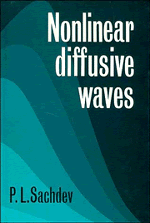5 - Numerical solution of nonlinear diffusion equations
Published online by Cambridge University Press: 01 October 2009
Summary
Introduction
It would be apparent from chapters 3 and 4 that analytic methods for nonlinear problems of diffusion (in common with all nonlinear problems) have severe limitations. For example, the non-planar N wave solution obtained by Crighton and Scott (1979) via matched asymptotic expansions, undoubtedly useful in the Taylor-shock regime, holds only over a certain finite time as detailed in chapter 3. The evolutionary shock regime after the Taylor shock and the subsequent decay later to the linear form are scarcely covered by analysis. The self-similar solutions discussed in chapter 4, although the only genuine exact solutions of nonlinear problems (when they exist), are special in nature. They may not exist for a given problem. Even when a self-similar form exists, it satisfies only special initial/boundary conditions so that a given physical problem dictating specific initial and boundary conditions will, in general, not have a self-similar solution. The latter almost always satisfies some singular initial conditions signifying its asymptotic nature. One naturally turns, therefore, to numerical techniques to get a clear qualitative as well as quantitative picture of the phenomena over the entire course of the wave. Since the problems that we discuss involve shocks with discontinuous or steep-fronted initial conditions and have an infinitely long time domain, the numerical methods must be sturdy enough to meet these exigencies. The finite difference or pseudo-spectral methods that may be used for such problems should have other necessary attributes, namely stability, convergence, small truncation error, in addition to economy in computational time in view of the large evolution time of the wave.
- Type
- Chapter
- Information
- Nonlinear Diffusive Waves , pp. 153 - 230Publisher: Cambridge University PressPrint publication year: 1987



